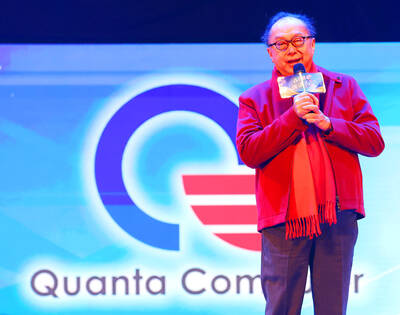Global shipments of large-sized liquid-crystal-display (LCD) panels are expected to increase 17.6 percent in the third quarter from the second quarter and 31.7 percent from a year ago because of rising demand, a market researcher said last week.
The large-sized panels — those having a diagonal dimension of 10-inches or more — are used mainly for desktop monitors, laptop screens, LCD TVs and other applications.
Shipments of such panels will reach 152.8 million units in the third quarter, compared with 129.9 million units in the previous quarter and 116 million units a year earlier, DisplaySearch said in a report released on Aug. 6.
“Panel makers are increasing capacity utilization to respond to growing demand,” the report said.
DisplaySearch said the industry’s positive momentum would continue to grow in the third quarter, predicting that the utilization rate among makers would rise to 87 percent for the quarter from 80 percent in the previous quarter.
The researcher also forecast that panel makers would rake in combined revenue of US$19.8 billion in the July-September period, up 32 percent from the second quarter and 10 percent from a year earlier, if manufacturers achieve their unit shipment targets.
DisplaySearch’s forecast came after AU Optronics Corp (友達光電) and Chi Mei Optoelectronics Corp (奇美電子), Taiwan’s two biggest flat-panel makers, reported smaller-than-expected losses in the second quarter and said they planned to step up expansion in the third quarter, boosted partly by rising demand in China from various domestic stimulus programs there.
AU Optronics, also the world’s third-largest LCD panel maker, said on July 23 it would increase production to cope with growing demand for LCD TVs, but could satisfy only 80 percent of demand in the July-September quarter.
Chi Mei Optoelectronics, the world’s fourth-largest flat panel maker, said on July 30 its third-quarter shipments of large-sized panels would rise between 15 percent and 20 percent from 19.13 million units in the second quarter and forecast its utilization rate would rise to between 90 percent and 95 percent in the third quarter, from between 80 percent and 85 percent in the second quarter.
Stocks of AU Optronics have risen 41.3 percent so far this year, closing at NT$34.9 on Thursday on the Taiwan Stock Exchange, while Chi Mei shares have expanded 63.89 percent to NT$17.7 over the same period. The benchmark TAIEX has grown 49.6 percent in the mean time.
“In the second quarter, the industry experienced a strong recovery and shipments reached record highs. We expect that strong demand will push panel shipments to another record high in the third quarter,” David Hsieh (謝勤益), vice president of DisplaySearch, said in the quarterly report.
“However, strong panel shipments in some cases are due to downstream players piling up inventory, so we believe it will be necessary to watch the supply chain inventory situation closely at the end of third quarter,” he said.
In the April-June period, LG Display Co of South Korea took the lead in unit shipments, with Samsung Electronics Co and AU Optronics ranking second and third, respectively.
Overall, South Korea remained the largest supplier of large-sized panels, grabbing 49.8 percent global market share in the second quarter, compared with Taiwanese makers, with 41.2 percent, the report said.
The recovering global economy has increased demand for consumer electronics and personal computers, while the problem of a glass substrate shortage is expected to further drive up prices for large-sized panels in the third quarter, after four months of consecutive price hikes.
“Prices could rise by as much as a US$6 to US$10 increase for monitor panels, US$10 to US$15 for notebook panels and US$20 to US$30 for television panels,” researcher iSuppli Corp said in an Aug. 3 report.
While makers of large-sized panels are expected to reach profitability in the second half of the year on the back of rising shipments and prices, a price correction could hit the industry sometime in the fourth quarter after prices peak in the current quarter, capping the magnitude of potential profitability.
“Increases in pricing and shipments are expected to peak in August and then start to slow in September because of seasonality and the end of inventory build-up,” iSuppli said.

Quanta Computer Inc (廣達) chairman Barry Lam (林百里) is expected to share his views about the artificial intelligence (AI) industry’s prospects during his speech at the company’s 37th anniversary ceremony, as AI servers have become a new growth engine for the equipment manufacturing service provider. Lam’s speech is much anticipated, as Quanta has risen as one of the world’s major AI server suppliers. The company reported a 30 percent year-on-year growth in consolidated revenue to NT$1.41 trillion (US$43.35 billion) last year, thanks to fast-growing demand for servers, especially those with AI capabilities. The company told investors in November last year that

Intel Corp has named Tasha Chuang (莊蓓瑜) to lead Intel Taiwan in a bid to reinforce relations between the company and its Taiwanese partners. The appointment of Chuang as general manager for Intel Taiwan takes effect on Thursday, the firm said in a statement yesterday. Chuang is to lead her team in Taiwan to pursue product development and sales growth in an effort to reinforce the company’s ties with its partners and clients, Intel said. Chuang was previously in charge of managing Intel’s ties with leading Taiwanese PC brand Asustek Computer Inc (華碩), which included helping Asustek strengthen its global businesses, the company

Taiwanese suppliers to Taiwan Semiconductor Manufacturing Co. (TSMC, 台積電) are expected to follow the contract chipmaker’s step to invest in the US, but their relocation may be seven to eight years away, Minister of Economic Affairs J.W. Kuo (郭智輝) said yesterday. When asked by opposition Chinese Nationalist Party (KMT) Legislator Niu Hsu-ting (牛煦庭) in the legislature about growing concerns that TSMC’s huge investments in the US will prompt its suppliers to follow suit, Kuo said based on the chipmaker’s current limited production volume, it is unlikely to lead its supply chain to go there for now. “Unless TSMC completes its planned six

TikTok abounds with viral videos accusing prestigious brands of secretly manufacturing luxury goods in China so they can be sold at cut prices. However, while these “revelations” are spurious, behind them lurks a well-oiled machine for selling counterfeit goods that is making the most of the confusion surrounding trade tariffs. Chinese content creators who portray themselves as workers or subcontractors in the luxury goods business claim that Beijing has lifted confidentiality clauses on local subcontractors as a way to respond to the huge hike in customs duties imposed on China by US President Donald Trump. They say this Chinese decision, of which Agence